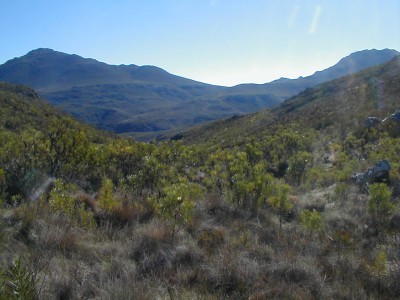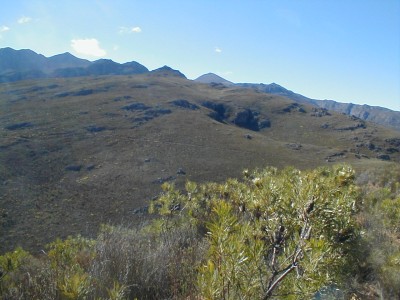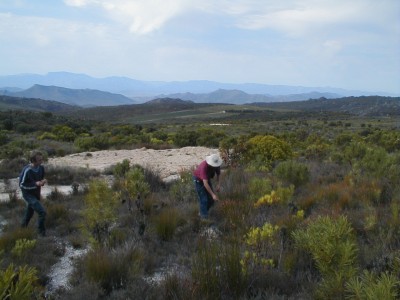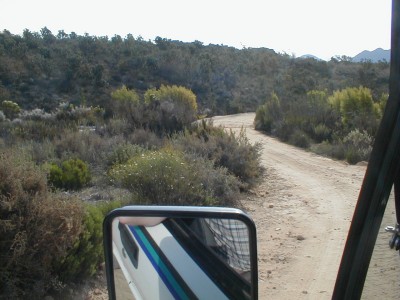
Home
Mission
Overview of Project
Project Staff
Sponsors
Achievements
Checking, Illustrations
Upcoming Activities
Id and Species Lists
Protea Information
Protea Gallery
Growing Proteas
Interim Dist. Maps
Publications
Afrikaanse Inligting
![]()
Rayner Trophy 2003 - Model Answers for Environmental Awareness
 The Environmental Awareness award, a copy of the book
"SASOL
Proteas", went to the top five patrols who excelled in environmental
awareness. Marks towards this award came from the following activities: Bird
List, Flora Report, Outdoor Code, Protea Identification, Spoor/Footprint identification
and Vegetation Plot. The Award was sponsored by The Protea Atlas Project www.nbi.ac.za/protea
of the National Botanical Institute www.nbi.ac.za,
in order to increase the environmental and botanical awareness of Scouts hiking
through one of the richest plant areas in the worlds hottest hotspots of
biological diversity the Cape Floral Kingdom.
The Environmental Awareness award, a copy of the book
"SASOL
Proteas", went to the top five patrols who excelled in environmental
awareness. Marks towards this award came from the following activities: Bird
List, Flora Report, Outdoor Code, Protea Identification, Spoor/Footprint identification
and Vegetation Plot. The Award was sponsored by The Protea Atlas Project www.nbi.ac.za/protea
of the National Botanical Institute www.nbi.ac.za,
in order to increase the environmental and botanical awareness of Scouts hiking
through one of the richest plant areas in the worlds hottest hotspots of
biological diversity the Cape Floral Kingdom.
The environmental awareness award was an "arb" award it will probably not feature in many Rayner Trophys, but that will depend on the organizer. It was interesting that the top 5 Rayner teams were not that close to the top environmental teams. That said, environmental awareness clinched the prize for the winning team, which had 80% of its lead in points based on its sound environmental awareness.
For those interested in the answers to the questions for the environmental tasks at the Rayner, herewith some information on what was expected and how the teams performed.
STA2 - Flora Report
 This is a composite report based on the products of Teams 2
(best short summary), 5 (best overall, with short geographical account and
executive summary to questions), 14 (best geographical account), 20 (interesting
ancillary information). On the whole this question was not answered very well,
but the top teams did a splendid job.
This is a composite report based on the products of Teams 2
(best short summary), 5 (best overall, with short geographical account and
executive summary to questions), 14 (best geographical account), 20 (interesting
ancillary information). On the whole this question was not answered very well,
but the top teams did a splendid job.
Base 1 (Start) Base 2 (Water rescue)
Here the walk was through Apple orchards. Harvesting has begun. Pines and Oaks (as wind breaks) and Willows have been planted. Brambles (aliens) are spreading along the road near the dam, but unfortunately were not in fruit because they were sprayed with herbicide, but are recovering. This area is protected from fire.
Base 2 Base 3 (Scout Laws)
More apple orchards, and then Pine plantation/invasion on the left. Some riverine vegetation is still intact in places, but most of it is invaded or planted over (this is now illegal). Brambles on side of the road. Blue Gums (alien) seen.
Pine plantations on the left (west), and good fynbos on the right. Proteoid fynbos, with Protea neriifolia Narrowleaf Sugarbush and Protea repens Common Sugarbush dominating, and Erica longifolia just going over. Soil slightly shaley would make good apple orchard. Fynbos without any major invasives. Veld about 5 years old.
Base 3 Base 4 (Observation)
Ditto above, until we left the road., then:
Walked through pristine Fynbos, Ericaceous, with Cliffortia ruscifolia (Climbers Friend) along the path to scratch us, and other wettish Fynbos species. Soil is now just white sand. Very little leaf litter. Quite a lot of Hakea sericea (alien), but still small plants. Veld about 5 years old.
Base 4 Base 5 (Vegetation)
Mostly Proteoid Fynbos, dominated by Protea repens and restios. Initially wet with tall proteas and Leucadendron salignum Common Sunshinebush, it became a drier vegetation type further along the track.
Fair amount of aliens (Hakea, some pines), especially on west of road.
East side 5 years old, West side 10-15 years since last fire.
I cant believe it. They gave us tons of information for the flora report at this base. And they answered all our questions when we asked them the different plant species names. The Protea skeletons we saw were killed in the last fire, 5 years ago. Some plants like the Protea scabra resprouted from an underground rootstock after the fire, but the Protea repens only comes up from seeds.
In flower were: Erica coriifolia (Heath Family), Lobelia sp Wild Lobelia, Erepsia anceps Vygie, Tritoniopsis triticea - Iris Family (one of the red flowers pollinated by the Pride of Table Mountain Butterfly). The Everlastings (Sewejaartjies) were loosing their flowers, so must be in seed.
Base 6 Base 7 (Woggle Plait)
Ditto above, with some Leucospermum calligerum Arid Pincushion along the path, and becoming drier so proteas dropped out and it turned to Restioid Fynbos.
Base 7 Base 8 (Cliff)
These southern slopes have lots of Ericas, so should be Ericaceous Fynbos, except that Protea repens dominates, so it is Proteoid Fynbos. This must be a wet slope. No aliens seen.
Veld about 5 years since last fire, but Protea repens has not set any seed (no seedheads visible on plant), so the veld is not yet ready to burn at least for Protea repens.
Looking down one can see a Thicket patch this may be an old kraal (where the KhoiKhoi kept their sheep) or a heuweltjie (termite mound), which has an old Olive Tree in the centre and other bushes around.
Base 8 Base 9 (Panoramic sketch)
The hill is a rocky area and has lots of daisies that like the fire protection the rocky outcrop gives them. Nothing much in flower, but then this is the middle of the hottest month any clever plants are dormant and waiting the autumn, winter and spring rains to grow and flower.
Base 9 Base 10 (Base position)
Here we were walking mainly through Restioid Fynbos. A low pleasant to walk through vegetation type. In a few patches we saw Hakea clumps which are starting to set seed and should be chopped out. A few clumps of Leucadendron laureolum stood out above the Restios. In the seeps (areas where water is flowing all year) dense patches of Restios were seen. Soil is still white sand.
Veld 5 years old. fortunately! It would be very dangerous to camp and cook if the veld were any older the risk of fire would just be too high.
Had to hand in this report.
What is in flower?:
Erica longifolia, Erica coriifolia, Lobelia, Erepsia anceps, Tritoniopsis alata - Nothing much, but then this is the middle of the hottest month. Had hoped to see some orchids (The red Cluster Orchid another red butterfly flower - should have been flowering), but we only saw one I dont know its name.
Any aliens?
Pines, Blue Gum, Hakea, Black Wattle, Brambles are a problem. Apples, Oaks and Willows also noted, but not a problem. However, overall the Fynbos had very low levels of infestation, except for one clump near the end.
When was the veld last burned?
Mainly 5 years ago, but below the road 10-15 years ago. Fortunately we spent our time in the young veld! It would be very dangerous to camp and cook if the veld were any older the risk of fire would just be too high. Not to mention horrible to walk through!
 Anything else?
Anything else?
The diversity is amazing.
What a floral experience.
The plants/fynbos was not nice to us scratching our legs like.
Some errors:
- The Fynbos is not 1-2 years old since the fire. It takes much longer for plants to grow on such nutrient poor soils.
- The presence of charcoal and burnt stems can last for 5-10 years in Fynbos, because decomposition is so slow things just dont rot! Instead it all burns in the next fire.
- Restios are not a grass! You were told so at the vegetation station!
- The ferns observed were not aliens! They are indigenous to the area.
- Pine needles do not make the soil much more acid than it is. Fynbos soils are naturally very acidic. Pines do use up lots of water though.
- Misreading the question "What is in flower" as "What is in a flower" is an error. Eloquent as the response was, it was not the question.
- Proteas are not our national flower only one of the 380 species in the family in South Africa, and one of the 100 species of the genus Protea is our national flower the King Protea Protea cynaroides.
- We did not penalize those groups, who despite the Vegetation Community Plot, insisted that Fynbos was dominated by grasses. Botanically this is a major fauxpas and should have been marked as an error. Fynbos is dominated by Cape Reeds (Restionaceae or Restioids), which are essentially "Woody Grasses", but are not in the same family as Grasses (Poaceae, or Graminae), or even Sedges (Cyperaceae).
General
Few teams did justice to the Flora report. We wanted to see how observant you were, and how good a report you could write. Valuables clues were given at the Vegetation Plot, and you should have extracted lots of terms and ideas from the base for use in the Flora Report.
The ideal length of the report should be between one and two pages (500-1000 words - no more), excluding drawings and maps. However, keep it short - don't waffle - you may say foolish things and loose marks, you may bore or irritate the judge and loose marks. Remember to stick to what you saw - details of Kogelberg dam <interesting, but not an issue in this area>, Rooikrans infestations <there were none on the route>, and animals seen <don't repeat your bird list. Don't list all the insects or plants you know. Stick to pollinators and seed eaters/distributors and herbivores that you saw>. Be careful: in the Western Cape many species are very specific to vegetation type, time of year and mountain range - do not write something you saw last week or on your last hike! You will be found out, and your observations weakened, costing you points. If you want to use a brochure or strip map format, do this in addition to your written report, not in place of it. If you did a strip map, map, species list or something to help you to remember what to put into your report, then attach this as an appendix - it might really impress the judges and give you bonus points
Marking: Marks were awarded for plants and vegetation types mentioned, aliens mentioned (provided it was obvious that you knew they were aliens), and answers to the questions. Bonus points were given for interesting observations and exciting layouts. Maps and strip maps of vegetation types and land use were permissible, but had to be accompanied by a written report as well. Scientific (or Latin or Swear) names were not required, and heath, iris, sugarbush and so forth were perfectly adequate.
Breakdown of marks (mean = 32%) - 0: 4; 1: 2, 2: 5, 3: 5, 4: 2, 5: 2, 6: 4, 7: 1, 8: 1, 9: 0, 10: 0.
No 6 Vegetation Community Plot
This was a skew ball. No one could have anticipated this. Its purpose was to make you realize that there was much more going on under your feet and noses than just grasses and scratchy bushes. For the rest of the hike, you should have been noticing plants as you plod along, and hopefully also put them into their categories. This also tested your ability to work through a novel problem and work as a team to get the task done quickly.
|
Plant group |
No of species per Site |
||||
|
A |
B |
C |
D |
E |
|
|
Proteoid |
2 |
1 |
2 |
2 |
2 |
|
Ericoid |
1 |
1 |
1 |
2 |
1 |
|
Graminoid |
3 |
2 |
5 |
3 |
2 |
|
Restioid |
4 |
5 |
5 |
4 |
4 |
|
Other (Asteroid) |
14 |
9 |
9 |
10 |
14 |
|
Total |
24 |
18 |
22 |
21 |
23 |
All sites keyed out as Restioid Fynbos based on their cover, but when mature (at 15 years old veld now 5 years old), would be Proteoid Fynbos as the Proteas will outgrow and overshadow all the other growth forms. We did not penalize those who keyed it out to Asteraceous Fynbos, as in this young veld, the Asteraceae were almost dominant, as they often are on drier, rocky areas. Grassy Fynbos was wrong, but because some teams were a little extravagant with Graminoids, if they had the Graminoid as the highest species richness, we gave them marks for classifying this as Grassy Fynbos which it is not!
One team scored 95%, but lost 1 mark for classifying the vegetation as Karoo. Karoo is characterized by succulent (vet) plants, occurs in dry areas, and does not burn. This was definitely not Karoo!
The proteas present were Protea repens and Protea scabra. The divided leafed resprouter Serruria gremialis Riviersonderend Spiderhead present in all plots is also a member of the Protea Family, but does not count as a Proteoid-leaf Shrub.
The score was calculated from the total seen as the proportion of species present. No one overestimated.
Most results were very accurate, except for the "Other" category, where most teams underestimated species richness by ½ to 1/8 of species present. Surprisingly, no one overestimated the number of Restioids by double by counting both males and females as separate species.
Breakdown of marks (mean = 52%) - 0: 0; 1: 3, 2: 8, 3: 11, 4: 4, 5: 0.
No 17 Footprints
Teams should have expected and done better at this test. This is almost a standard test, and everyone should have gotten full marks.
1. Porcupine (not Honey Badger - longer claws & does not normally have long base to foot, not Aardvark - walks only on toes no pads, not Dassie - 4 fingers & 3 toes, Otter no back pad,
definitely not: Baboon, Bear, Cheetah, Hare, Mongoose, Water "Monguse", or Rodent {although technically the Porcupine is a rodent, this answer was not adequate})2. Grysbok (also Duiker, Buck, Dikdik, but not Klipspringer two round "shots". Also not accepted small deer, or pig)
3. Hippopotamus (not Rhino (3 toes), definitely not "Abomidabil Snowman", Badger, Bear, Beaver, "Cuwala Bear", Crocodile, Dinosaur, Gorilla, Komodo Dragon, Lion, or "Linx")
4. Caracal <or Lynx, Rooikat all the same> (too small for Leopard, too big for Wild Cat or "Jennit" <Genet>,
definitely not: Dog, Jackal, or Meerkat (no claw marks))5. Baboon (Ape not accepted, nor Monkey)
Most teams got the Grysbok and Baboon correct. Few (3 correct) got the Porcupine. The Hippo fooled most (3 correct) the size should have given it away immediately. Remember to look for claw marks to distinguish cats from dogs too few teams (only 7 correctly said cat) paid attention to this. No team got more than three correct. Quite a few teams did not attempt this task, which was money for jam.
Breakdown of marks (mean = 26%) - 0: 10; 1: 3, 2: 7, 3: 6, 4: 0, 5: 0.
No 25 Bird List
This was almost a trick question. There are very few birds in Fynbos. What we were looking for was keen observation, reasons, proof and knowledge of what should be there. The following were reasonable possibilities:
Fynbos: Black Eagle, Rock Kestrel, Buttonquail, Swift, Swallow, Ground Woodpecker, Cape Rockjumper, Cape Rockthrush, Stonechat, Victorins Warbler, Grassbird, Neddicky, Cape Sugarbird, Orange-breasted Sunbird, Protea Canary, Cape Bunting, Cape Sisken.
At the dam: Cormorant, Darter, Yellow-billed Duck, Cape Shoveler, Red-billed Teal, Egyptian Goose, Blacksmith Plover, Pied Kingfisher.
Orchards: many birds of prey, Cape Sparrow, Olive Thrush, Cape Robin, Mousebirds, Nightjar, Cape Canary, Bully Canary, Cape White-eye.
Birds claimed to be seen were (the number is the number of teams):
Black Eagle 6
Pigeon 4
Cape Sugarbird 3
Finches 3
Hawk 3 (a "predature")
Kite 2
Mousebird 2
Orange-breasted Sunbirds 2
Sparrows 2
Buzzard 1
Buzzard/Kite 1
Cape Rock Jumper - 1
Cape Sparrow 1
Cape Sparrow (heard only) 1
Cormorant 1
Duck 1
Eagles 1
European Starlings 1
Fiscal Shrike 1
Golden Condor 1 (An African first)
Hawk 1 (well illustrated, as a White-necked Raven)
Hummingbird/Sunbird 1
Joyful pair of finches 1
Kestral Eagle 1 (Brown, medium sized, big feathers)
Lanner Falcon 1
Lesser-speckled Warbler 1 (A new species to science)
Orange-breasted Swallow 1 (A new species in Fynbos)
Pietmyvrou 1
Rabbit 1
Red-eyed Doves 1
Robin 1
Small seed eating birds 1
Starling 1
Sunbird 1
Turtle Dove 1
Unknown pollinator 1
Wagtail 1
Nothing at all 3
 Some comments included:
Some comments included:
- At this height there are few trees or flowering bushes. This limits the bird life to only those who can survive off the proteas and ground. In this area one can also see Black Eagles, but we were not fortunate to see one.
These earned points. The following expressed teams frustration, but not giving any valid explanation, did not earn bonus points:
- As a team we havent seen
many birds. I dont think that any birds will fly as high as we are, or will fly in these mountains. <Judges comment: when the proteas are in flower, these hills team with birds>
- This sparseness of birds was a great disappointment, and this disappointment was only added to the next day, when we woke up expecting bird songs and found nothing. We hope for better luck later.
- To whom it may concern: we are very sorry due to the fact that we did not see any birds.
- We have seen very few birds so far on this hike.
- We saw nothing (too misty).
The following was tongue-in-cheek and so got only 5 trillion imaginary marks.
- The ornithology of this area is truly amazing, we encountered many different species and were awestruck by their beauty, particularly the common pigeon.
The average number of species per team was 2.6 species. A more reasonable average would have been 1.8 species. The correct explanation for the lack of numbers of birds is the low nutrients in Fynbos, which means that there is little primary production and thus no food (no fruit, few insects, few lizards) and hence low biomass of birds or few birds. The most abundant birds are the nectar-feeding species. However, diversity the number of species - is high, you just have to work very hard to see them. Some sparse species are very visible e.g. the Black Eagle. A further factor affecting bird numbers is the time of the year with the streams drying up, most birds would have moved off to areas that are nearer water. This would make it more difficult to get up a good bird list.
Points were awarded for reasonable sightings, details of where the birds where seen, notes and descriptions of the sightings, and explanations and notes for the low tallies, and any other interesting observations. Because of the lack of birds, 2 points were awarded to all teams who submitted lists, 1 point for the species (or none) being realistic, 1 point for additional notes and 1 point for explanations. A bonus point was given for a well-presented report.
Breakdown of marks (mean = 52%) - 0: 5; 1: 0, 2: 5, 3: 5, 4: 9, 5: 2.
No 35 Protea Identification
 This was another skew ball. But on your walk you were within 50m of over 80
species of Protea. It would have been a crime not to make you stop and work out
what at least a few were. We chose three species the first (A) all those on
the Cedarberg Adventure would have recognized immediately. The second was to
show that some proteas have underground stems. The third was an introduction to
the Conebushes one of the dominant elements in Fynbos they are
responsible for changing the mountains from grey to bright yellow or red in
winter.
This was another skew ball. But on your walk you were within 50m of over 80
species of Protea. It would have been a crime not to make you stop and work out
what at least a few were. We chose three species the first (A) all those on
the Cedarberg Adventure would have recognized immediately. The second was to
show that some proteas have underground stems. The third was an introduction to
the Conebushes one of the dominant elements in Fynbos they are
responsible for changing the mountains from grey to bright yellow or red in
winter.
A genus: Protea; section: a Bearded Sugarbush; species laurifolia Grey-leaf Sugarbush checks large tree, oval leaf,
B genus: Protea; section: a Dwarf-tufted Sugarbush; species scabra Sandpaper-leaf Sugarbush checks rough leaves, flowers on ground,
C genus: Leucadendron; section: a Needle-leaf Conebush; species teretifolium Needle-leaf or Strawberry Conebush checks needle leaves, red cones.
Did you realize that while identifying the three proteas, you were in striking distance of over 15 species of proteas? Luckily they dont bite.
For the team that thought that identification was a "moffie base", I should perhaps point out that this sort of work is the basis of medicines, of breeding new genetic strains of crops (the average cereal cultivar lasts 3 years before diseases and pests overwhelm it), of forensic science and of conservation biology. If you really want to work in the great outdoors, the odds are you will be identifying plants quite often, even if it is only for tourists.
Points, 1 for each genus correct, 1 for each species correct, 1 if section correct even if species wrong. (i.e. your species was wrong, but it was in the correct group of proteas, plus ½ mark if sister species given in error). Bonus point for knowing you were in the richest area of the richest Floral Kingdom in the world. (Asked even of teams who skipped the base). Surprisingly, most of the best-scoring teams missed out on the bonus point!
Breakdown of marks (mean = 38%) - 0: 0; 1: 4, 2: 6, 3: 5, 4: 3, 5: 2, 6: 1, 7: 4, 8: 0, 9: 1, 10: 0.
No 38 Outdoor Code
Most scouts know their outdoor code. But of course, they should! This was the best scoring test on the Rayner Trophy. Perhaps we should make this test more difficult ..
Breakdown of marks (mean = 89%) - 0: 0; 1: 0, 2: 0, 3: 0, 4: 0, 5: 0, 6: 0, 7: 2, 8: 8, 9: 4, 10: 12.
Tony Rebelo
4 March 2003